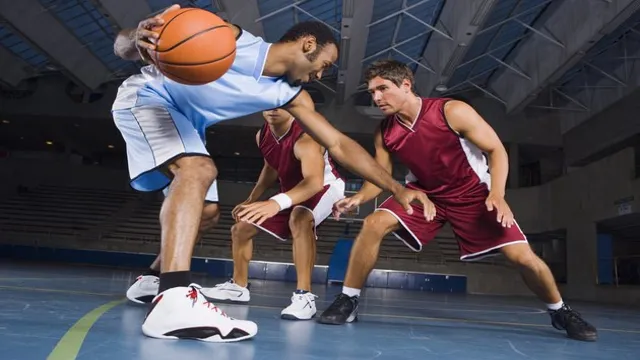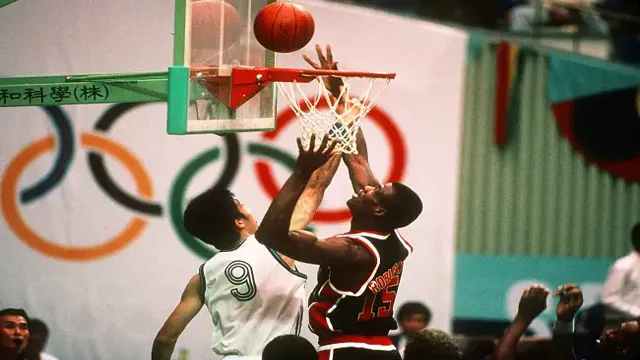Do you want to take your basketball game to the next level? Are you tired of feeling sluggish on the court and not being able to keep up with the competition? Look no further than “Basketball Up and Down: A Guide to Increasing Your Game Pace.” This guide will teach you everything you need to know about increasing your speed and agility on the court. No matter whether you’re a beginner or an advanced player, these tips and tricks will help you improve your game and outrun the competition.
So lace up your sneakers and get ready to soar to new heights with “Basketball Up and Down.”
What is Game Pace?
When it comes to basketball, game pace refers to the speed and intensity at which the game is played. It’s the balance between an up-and-down, fast-paced game and a slower, more controlled style of play. A team that wants to play an up-tempo, fast-paced game will look to push the ball up the court quickly, getting easy baskets in transition.
On the other hand, a team that prefers a slower game pace will take their time, look for good shots, and focus on controlling the game’s tempo. The key to success is finding the right balance between these two styles, depending on the team’s strengths and weaknesses. Ultimately, basketball is a dynamic sport that requires constant adaptation and adjustment to the game’s pace to win.
So, whether you prefer a high-scoring, fast-paced game or a deliberate, controlled style of play, understanding and mastering game pace is essential to success on the court.
Explaining the Importance of Basketball Tempo
Basketball tempo is crucial to any team’s success, as it dictates the flow of the game and can have a major impact on the final outcome. Game pace refers to the speed at which a team plays, including the speed at which they move the ball, how often they take shots, and how frequently they attempt to score. A team that plays at a slow pace will typically take fewer shots and play more defensively, while a team that plays at a faster pace will take more shots and play a more aggressive style of basketball.
The importance of game pace cannot be overstated, as it can be the difference between a successful season and a disappointing one. It’s crucial for coaches to understand their team’s strengths and weaknesses and to adjust the game pace accordingly, in order to maximize their chances of success. By controlling the tempo of the game, a team can dictate the flow of the game, limit their opponent’s scoring opportunities, and make strategic decisions that have a big impact on the outcome of the game.
So, if you want to succeed in basketball, understanding and utilizing game pace is absolutely essential.

How to Determine Your Team’s Ideal Pace
Game pace is the speed at which your team is expected to work, progress, and deliver results. Determining your team’s ideal pace can be challenging, but it’s essential to ensure that everyone is working at a sustainable speed that allows them to achieve the desired outcome without burning out. Factors that influence game pace include team size, workload, and complexity of tasks.
It’s important to consider the burstiness of tasks, or how irregularly they come up, and the perplexity of tasks, or how complex they are. A good way to determine your team’s ideal pace is to assess their performance and output regularly and make adjustments as needed. This can involve delegating tasks, setting more realistic goals, or balancing workload across team members.
By finding your team’s ideal pace, you can help them achieve success while avoiding the pitfalls of overwork and burnout.
Up Your Game: Tips for Playing at a Faster Pace
If you’re looking to improve your basketball game and play at a faster pace, there are a few key tips you should keep in mind. First and foremost, it’s important to focus on your conditioning and endurance, as being able to push yourself up and down the court quickly will undoubtedly give you an advantage. Additionally, practicing your footwork and honing in on your ball-handling skills will help you stay in control while moving at high speeds.
It’s also essential to have a solid understanding of your team’s game strategy and be able to quickly adjust to changing situations on the court. Remember, playing at a faster pace takes practice and dedication, but with the right mindset and skills, you can elevate your game and dominate on the court. So get out there and start working on your basketball up and down game!
Conditioning Drills to Help Increase Endurance
Conditioning drills are important for any athlete who wants to increase their endurance. Whether you are a runner, a basketball player, or a soccer player, having good endurance can give you an edge on the competition. One way to increase your endurance is to do interval training.
Interval training involves alternating periods of intense exercise with periods of rest or slower activity. This type of training can help condition your body to work harder for longer periods of time. Another drill that can help is hill training.
Running up hills is a great way to build leg strength and endurance. To take your conditioning to the next level, you can also try combining interval training with hills. The burst of intense activity followed by the uphill climb is a great way to challenge your body and build both endurance and speed.
By incorporating these drills into your training routine, you can up your game and play at a faster pace than ever before.
Offensive Tactics to Move the Ball Quicker
When it comes to soccer, one of the most important aspects of the game is speed. Players need to be able to quickly move the ball up the field and outmaneuver their opponents. To do this, offensive tactics are crucial.
One way to move the ball more quickly is to use short passes. Instead of trying to make long passes that are more difficult to complete, players can make quick, short passes that keep the ball moving and create more opportunities for scoring. Another tactic is to use dribbling skills to elude defenders.
By practicing dribbling drills and using quick, evasive moves, players can break through defensive lines and get the ball moving up the field faster. Additionally, using diagonal runs and off-the-ball movements can create space and open up passing lanes, making it easier to move the ball quickly. Overall, mastering offensive tactics is key to playing at a faster pace and upping your game on the soccer field.
Defensive Strategies to Force Turnovers and Speed up Play
When it comes to basketball, speed and turnovers are essential for getting ahead in the game. Defensive strategies can help you achieve both. For starters, consider putting pressure on your opponent by playing tight defense with constant movement.
This forces the opposition to make hurried passes or ill-advised shots, increasing your chances of securing the ball and scoring. Additionally, timing is crucial when attempting to steal the ball. Rather than waiting for an opponent to make a move, anticipate their movements and react accordingly.
It’s all about staying one step ahead. Remember, basketball isn’t just about offense; you need to bring your best game on the defensive end as well. By utilizing strategies aimed at forcing turnovers and speeding up play, you’ll have an edge over the competition and be on your way to winning games.
Down the Court: Managing Your Tempo and Avoiding Turnovers
Basketball is a game of tempo, and managing that tempo can be the difference between winning and losing. Knowing when to push the ball up the court, and when to slow it down, is a skill that top-notch basketball players have mastered. Players must be able to read the defense, identify weak spots, and make quick decisions.
A fast-paced “up and down” game can be exciting and can put pressure on the opposing team. Still, it can lead to turnovers if players aren’t careful. Turnovers occur when players lose control of the ball and give it to the opposing team, leading to lost opportunities to score.
To avoid turnovers, players need to maintain their focus, stay alert, and play smart. Minimizing turnovers can help a team stay competitive and maintain control of the game. In conclusion, playing basketball up and down is a strategy that can lead to success if done correctly.
However, it’s essential to be mindful of the tempo and avoid turnovers that can cost a team a game.
Maintaining a Fast Pace Without Losing Control
When it comes to basketball, managing your tempo can be the difference between scoring points and losing the ball. Maintaining a fast pace without losing control is key. One way to manage tempo is by controlling the ball and slowing down the game when necessary.
This gives you a chance to catch your breath and evaluate your options. But at the same time, it’s important to remain aggressive and keep the defense on their toes. Another crucial aspect of managing tempo is avoiding turnovers.
Turning over the ball can quickly shift the momentum in the other team’s favor, so it’s important to be smart with your passes and avoid taking unnecessary risks. Remember, in basketball, every possession counts. So, don’t be afraid to slow down and take your time, but at the same time, stay aggressive and keep pushing the ball down the court.
It’s all about finding that balance between speed and control.
Keys to Limiting Turnovers While Playing at a High Tempo
Playing at a high tempo is a thrilling way to play basketball. However, it comes with a fair share of risks, mainly turnovers. It’s easy for a player to get caught up in the heat of the moment and lose track of the ball, leading to turnovers.
But there are ways to keep the turnovers to a minimum. Firstly, remember to slow down when necessary. It might seem counterintuitive, but slowing down gives you time to think and assess your next move.
It also ensures your teammates are on the same page as you. Secondly, focus on maintaining spacing between players. It’s easier to avoid turnovers when everyone knows their position and maintains it.
Thirdly, learn how to anticipate the movements of the opposition. This way, you can predict their next move and make the most of the available space. Lastly, focus on making simple passes instead of fancy ones.
Although it may be fun to go for a flashy pass, it’s rarely successful and often results in turnovers. So, keep these tips in mind and enjoy your high-tempo game without the stress of turnovers!
Conclusion: Mastering the Up and Down Pace of Basketball
Like a game of basketball where the ball bounces up and down the court, life is also full of ups and downs. With each passing moment, we face different challenges and obstacles that push us to keep moving forward. The game teaches us to stay resilient, never giving up no matter how tough the opponent or the situation may seem.
And just like in basketball, a single shot can change the entire course of the game. So, let’s keep playing, keep striving, and never forget that the thrill of the game lies in the journey, not just the final score.
FAQs
What is the meaning of basketball up and down?
Basketball up and down refers to when a player dribbles the ball up the court, then brings it back down without shooting or passing.
Can a player move their feet while dribbling the ball up and down the court?
Yes, a player can move their feet while dribbling, but they must not take more than two steps without dribbling the ball.
What is the penalty for committing an up and down violation in basketball?
The penalty for committing an up and down violation in basketball is a turnover, and the opposing team gets possession of the ball.
Is it considered a travel if a player dribbles the ball up the court, stops, then starts dribbling again?
Yes, it is considered a travel if a player stops dribbling, then starts again while still possessing the ball, even if they do not take any steps.


